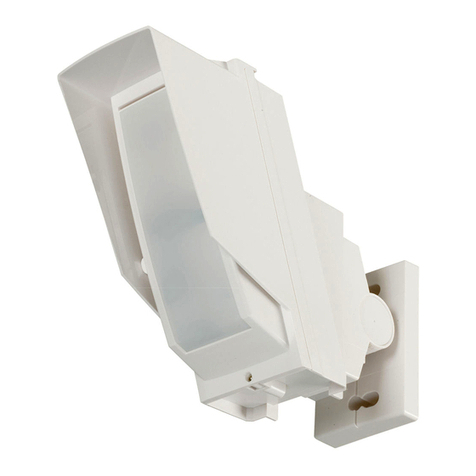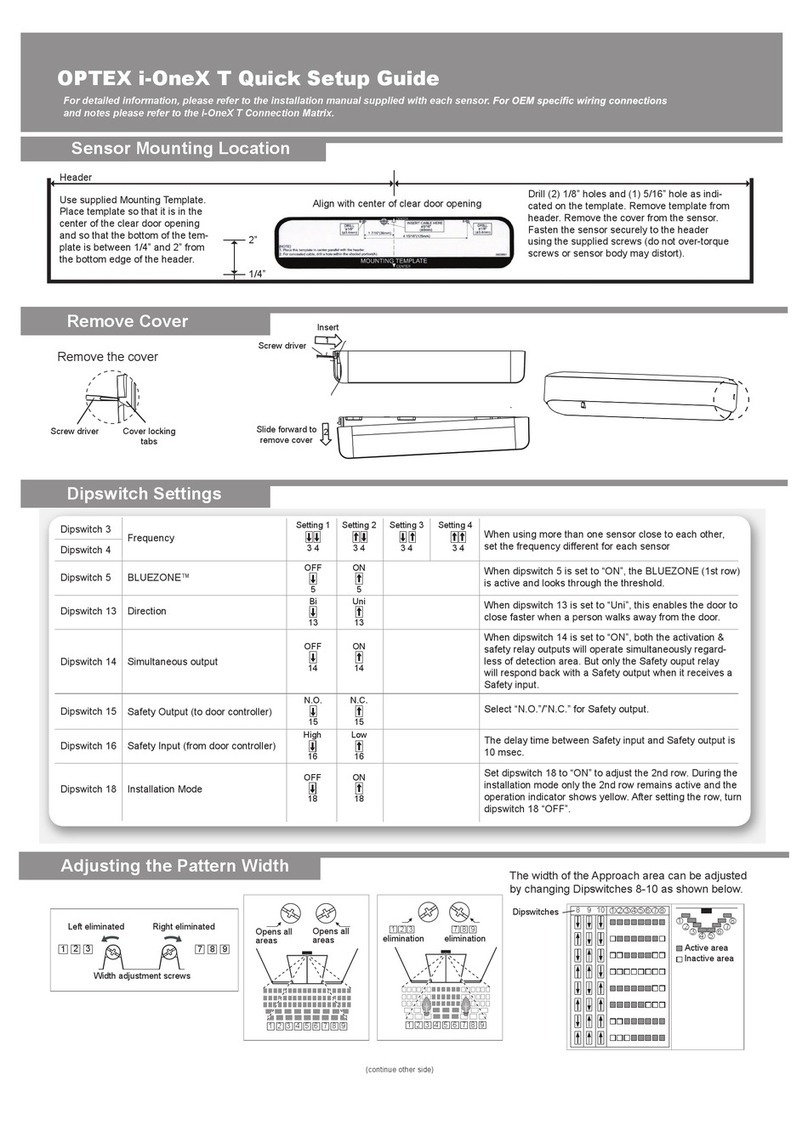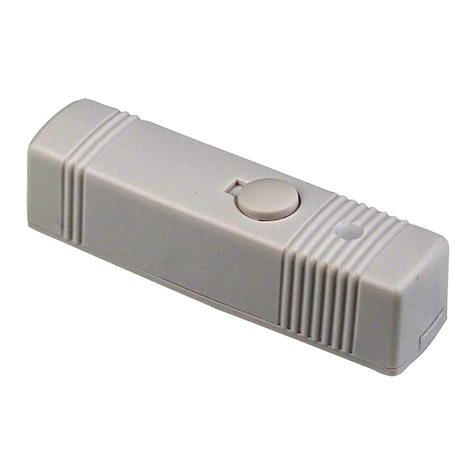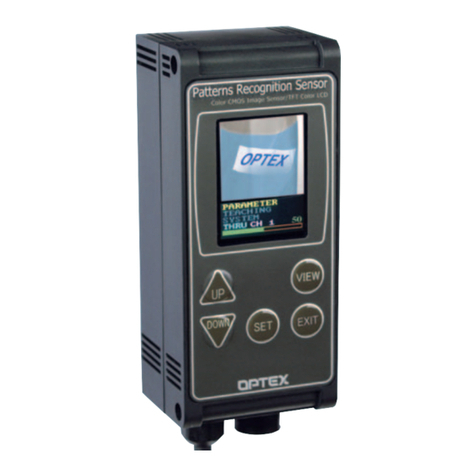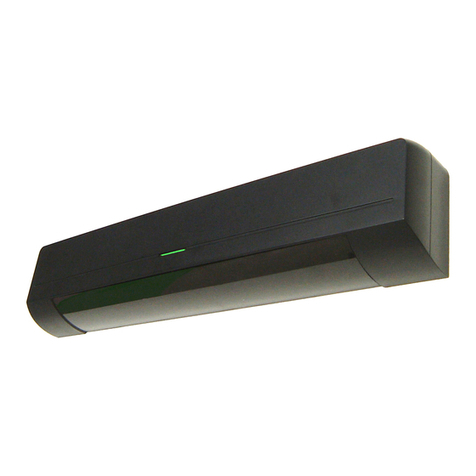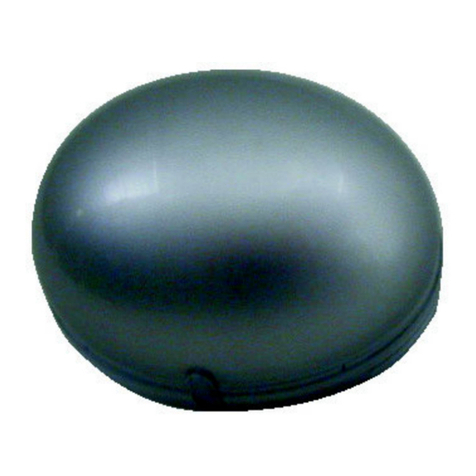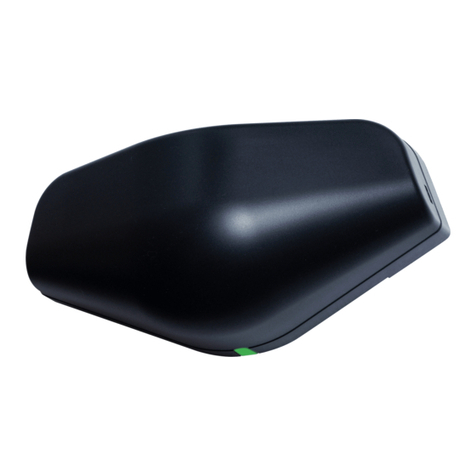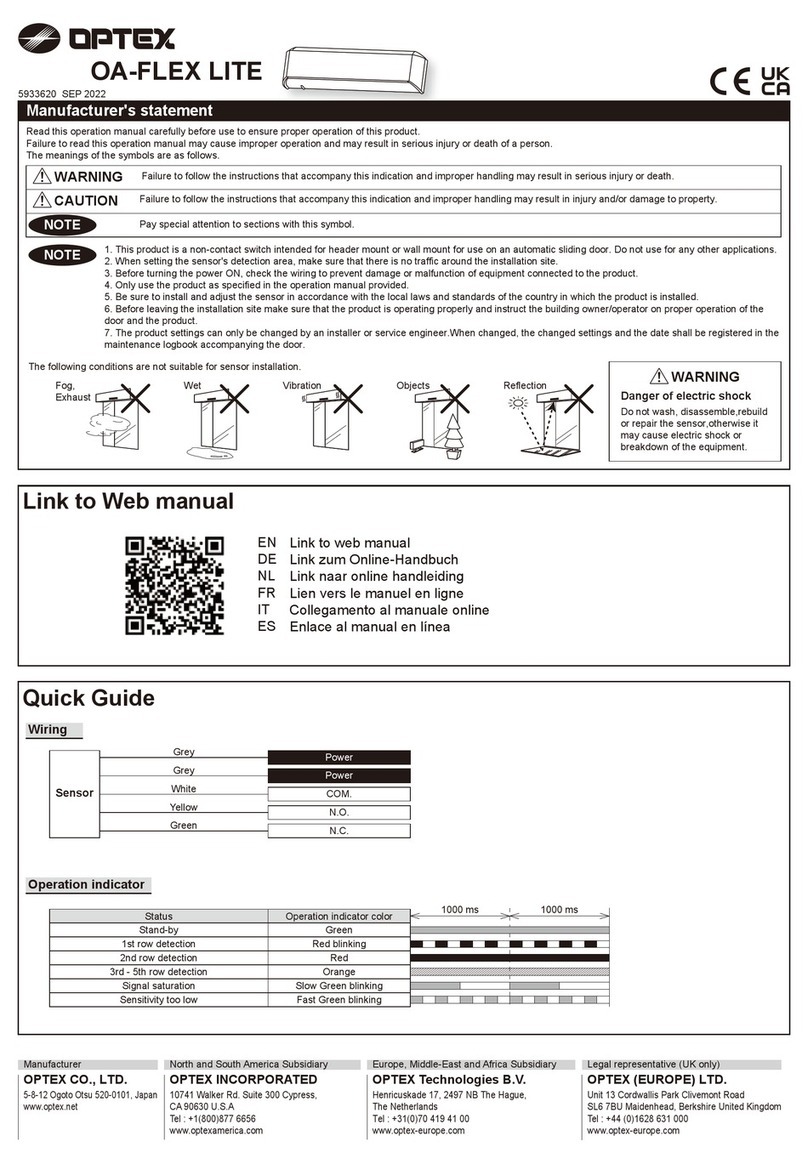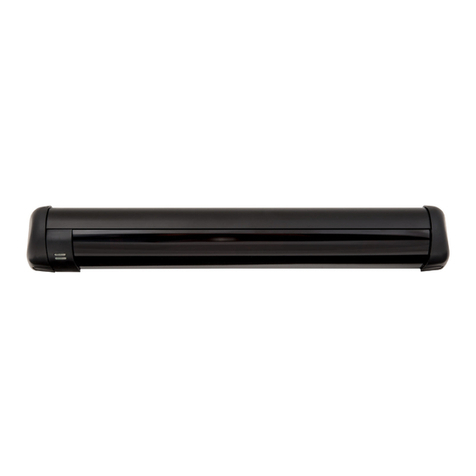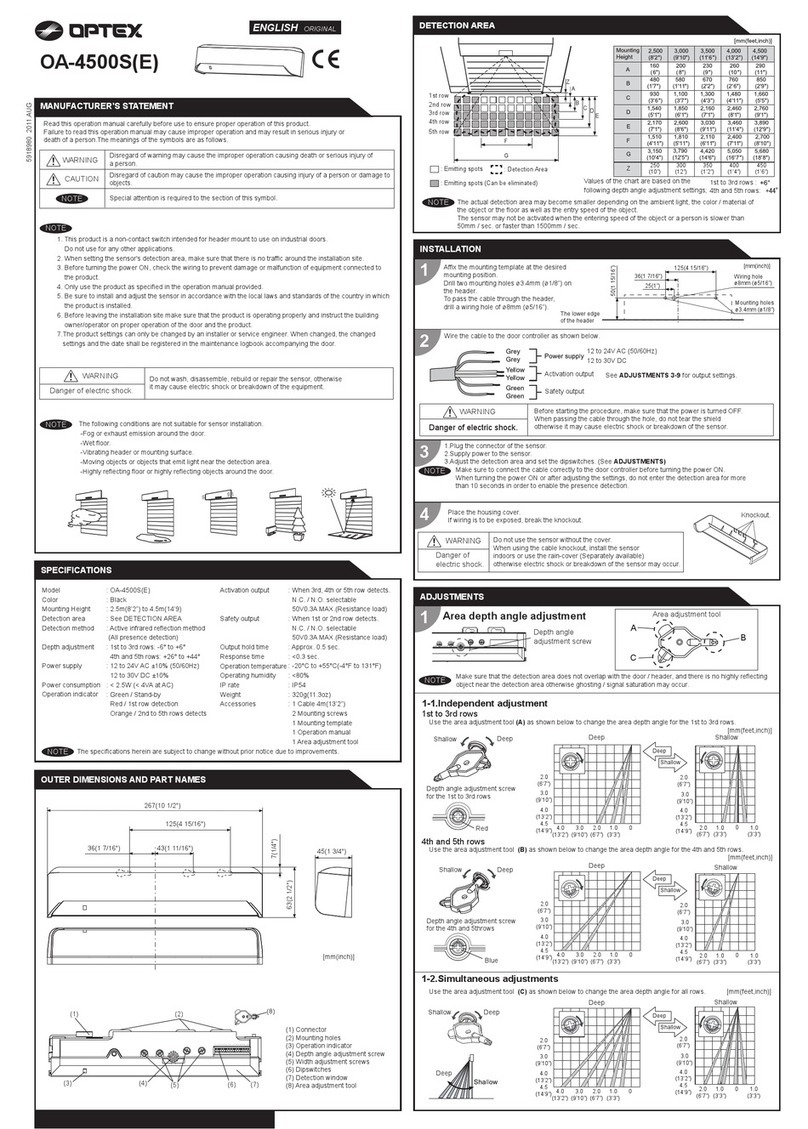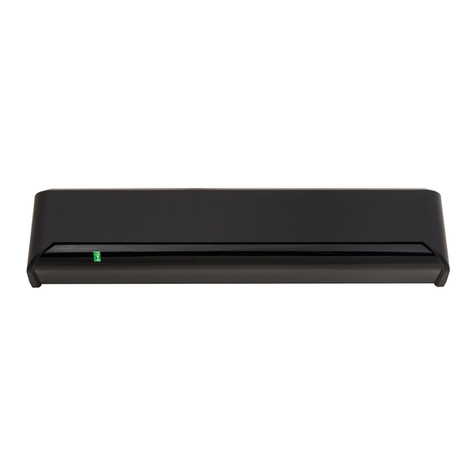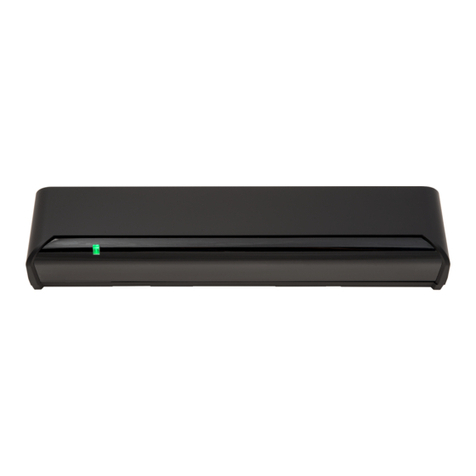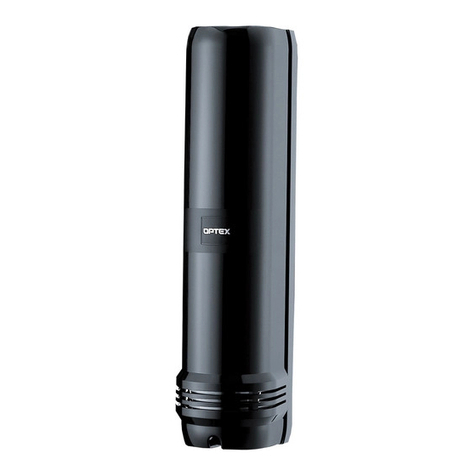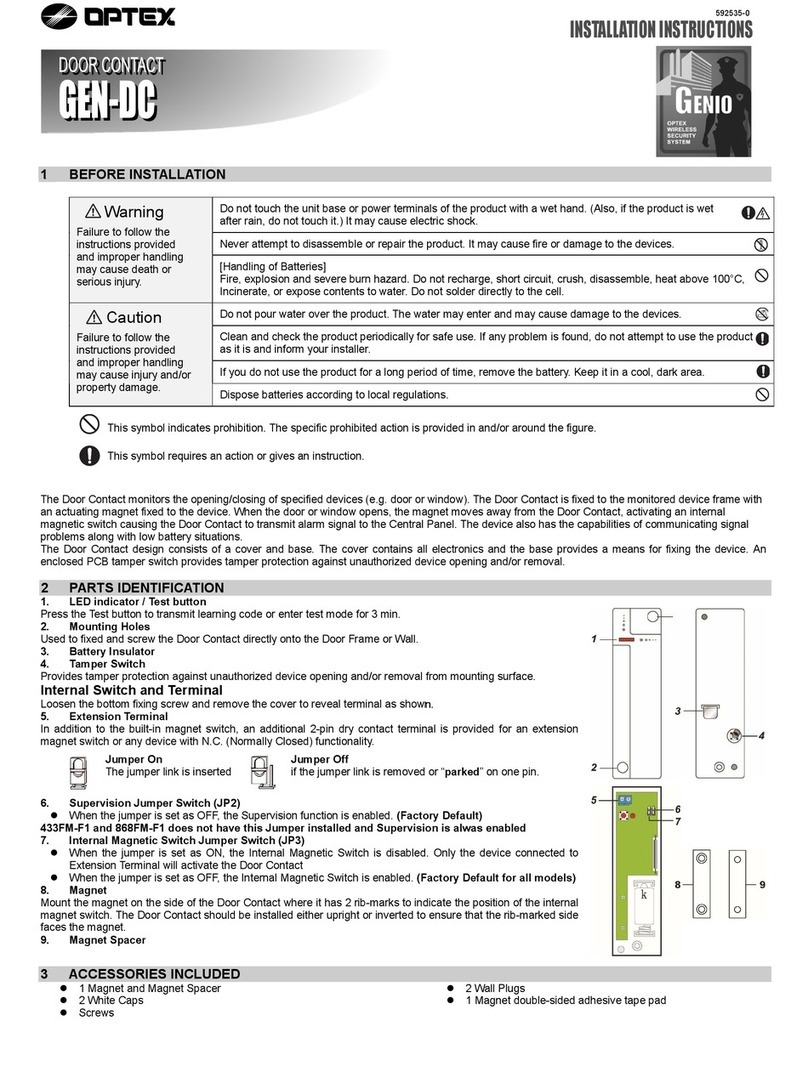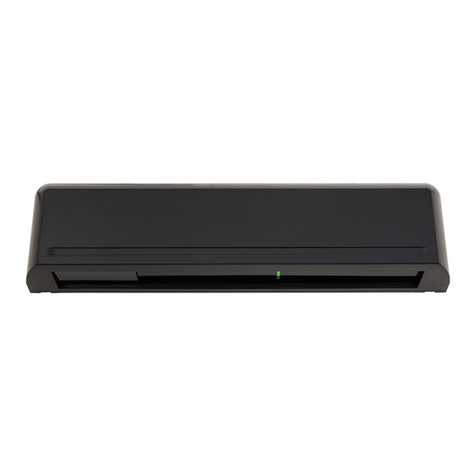
Manufacturer
5-8-12 Ogoto Otsu 520-0101, Japan
TEL.: +81(0)77 579 8700
FAX.: +81(0)77 579 7030
URL www.optex.net
OPTEX CO., LTD.
European Subsidiary
OPTEX Technologies B.V.
Henricuskade 17, 2497 NB The Hague,
The Netherlands
TEL.: +31(0)70 419 41 00
FAX.: +31(0)70 317 73 21
URL www.optex.eu
Regional Office DACH
Thaler Berg 11, D-84428 Buchbach
Germany
TEL.: +49(0)8086 947 87 00
URL www.optex.eu
Adjustments
When adjusting the 2nd row close to the door,
see Table 2 dipswitch 16 for the easier adjustment.
Make sure that the detection area
does not overlap with the door/header,
and there is no highly reflecting object
near the detection area otherwise
ghosting/signal saturation may occur.
Depth angle
adjustment
screw
Area adjustment tool
A
B
1. Area depth angle adjustment
NOTE
a. AIR adjustment b. Radar adjustment
Depth angle adjustment screw for the AIR area. Depth angle adjustment screw for the Radar area.
Use the area adjustment tool (A) as shown above to
change the area depth angle.
For the easier adjustment, see Reference.(Separate sheet)
Use the area adjustment tool (B) as shown above to change
the area depth angle.
Shallow Deep
Red
Shallow Deep
Blue
ShallowDeep
ShallowDeep
[feet,inch(m)]
1.0
(3′3")
1.0
(3′3")
0-1.0
(-3′3")
0
2.0 (6′7")
3.0 (9′10")
3.5 (11′6")
To adjust the AIR detection area width, use the
adjustment screws as shown in the picture below.
Width adjustment screws
Narrow
Wide
Eliminated
Eliminated
123 10 11 12
Please adjust
by using the tool (B).
a. AIR adjustment
2. Area width adjustment
Front view [m (feet,inch)]
4 9
1 12
~
~
:Wide
:Narrow
123 10 11 12
4 5 6 7 8 9
2.0
(6′7")
0
3.0
(9′10")
3.5
(11′6")
0
2.0
(6′7")
2.0
(6′7")
1.0
(3′3")
1.0
(3′3")
NOTE When setting the detection area
width, make sure to turn the
adjustment screws until it clicks.
cannot be eliminated
separately, neither can .
123
10 1112
After changing the dipswitch settings, make sure to push the function switch
for 2 s.
Table 2
4. Dipswitch settings Push 2 s
AIR settings Radar settings Other setting Factory default settings
Comment
Set the sensitivity according to the mounting
height. Values below dipswitches are
reference only. Adjust the sensitivity
according to your risk assessment.
3.0 to 3.5 m
21
Low
2.0 to 3.0 m
21
Middle
2.0 to 3.0 m
21
High
2.5 to 3.2 m
21
S-High
Setting
1
Function
Sensitivity
Dip
switch
No.
2
To enable the presence detection, do not
enter the detection area for 10 s after setting
the timer.
2 s
(Motion)*600 s30 s 60 s
43 43 43 43
Presence timer
3
4
Check the Radar output methods (Dipswitch 12,13)
before Frequency setting. Each of the methods has
only 2 Frequency settings. When using more than
one sensor close to each other, set the frequency
different for each sensor.
5 5
Setting 1 Setting 2
5 5
Setting 3 Setting 4
Frequency
5
The delay time between Test input and
Safety output is 10 ms.
If not use the Test input, dipswitch 8 set to
"High". *
When dipswitch 6 is set to
"Safety + Activation", the sensor outputs
safety and activation simultaneously.
6 6
Safety Safety +
Activation
AIR output
6
N.C.
7
N.O.
7
Safety output
(to door controller)
7
8 8
High Low
Test input
(from door controller)
8
When dipswitch 9 is set to "Uni", this setting
enables the door to close faster when a
person walks away from the door.
9 9
Bi Uni
Direction
9
To adjust the Radar detection area width, use the narrow lens as
shown in the picture below.
b. Radar adjustment
Adjust the Radar detection area with potentiometer. Afterwards,
make sure to push the function switch for 2 s.
3. Radar sensitivity
H
L
Top view
H
L
[m(feet,inch)]
1.0
(3′3")
2.0
(6′7")
3.0
(9′10")
0
3.0
(9′10")
2.0
(6′7")
1.0
(3′3")
03.0
(9′10")
2.0
(6′7")
1.0
(3′3")
Low High
Mounting height : 2.2 m (7'3")
Vertical adjustment : +35°
Wide area
Narrow area
Narrow lens1. Remove screw
2. Open
2. Open
* No EN 16005 compliance.
** Not for escape route.
Set dipswitch 16 to "ON" to adjust the 2nd row.
During the installation mode only the 2nd row
remains active and the operation indicator
shows yellow. After setting the row, set
dipswitch 16 to "OFF".
OFF
16
ON
16
Installation mode
16
CommentSettingFunction
Dip
switch
No.
* After changing the dipswitch and/or potentiometer settings, make sure to push the function switch for 2 s.
Wrong wiring or connection failure. Check the wires and connector.
Fast
Green
blinking
Dirty detection window. Wipe the detection window with a damp cloth.
Do not use any cleaner or solvent.
Sensitivity is too low. Set the sensitivity higher. (*)
Door opens
when no one
is in the
detection area.
(Ghosting)
Unstable
Sudden change in the detection area.
Check Table 2 dipswitch 1 to 4. (*) If the problem
still persists, hard-reset the sensor.
(Turn the power OFF and ON again)
Proper
Wrong setting of dipswitches. Check Table 2 dipswitch 7, 8, 12,13. (*)
Others Set dipswitch 11 to "ON". (*)
Waterdrops on the detection window.
The detection area overlaps with that
of another sensor. Check Table 2 dipswitch 5, 12,13. (*)
Objects that move or emit light in the
detection area. Remove the objects.
Sensitivity is too high. Set the sensitivity lower. (*)
Installation mode is set to "ON". Set dipswitch 16 to "OFF". (*)Yellow
Set dipswitch 9 to "Uni" and/or dipswitch 11 to
"ON".(*)
Raining or snowing.
Adjust the detection area to "Deep"(Outside).
Or set dipswitch 11 to "ON". (*)
Use the rain-cover. (Separately available)
Or wipe the detection window with a damp cloth.
Do not use any cleaner or solvent.
Or install in a place keeping the waterdrops off.
Proper
The detection area overlaps with the
door/header.
Door operation Operation
indicator Possible cause Possible countermeasures
None Wrong power supply voltage. Set to the stated voltage.
Wrong wiring or connection failure. Check the wires and connector.
Door does not
open when a
person enters
the detection
area.
Unstable
Wrong detection area positioning. Check Adjustments 1, 2, 3. (*)
Sensitivity is too low. Set the sensitivity higher. (*)
Short presence timer. Set the presence timer longer. (*)
Dirty detection window. Wipe the detection window with a damp cloth.
Do not use any cleaner or solvent.
Wrong wiring or settings. Check the wires and/or dipswitches.Proper
Door remains
open
Troubleshooting
Contact your installer or service engineer.Sensitivity too low or sensor failure.
Signal saturation.(2nd or 3rd row)
The detection area overlaps with the
door/header. Adjust the detection area to "Deep"(Outside).
Slow
Green
blinking
Remove highly reflecting objects from the
detection area. Or lower the sensitivity. (*)
Or change the area depth angle for AIR area.
Setting error.
Red &
Green
blinking
After changing the dipswitch and/or potentiometer
settings, make sure to push the function switch for
2 s.
Remove highly reflecting objects from the
detection area. Or lower the sensitivity. (*)
Or change the area depth angle for AIR area.
Proper
operation
Signal saturation. (BLUEZONE)
Slow
Green
blinking
Service mode is enabled.
Yellow &
Green
blinking
Switch to the Operation mode that keep pushing
function switch until the operation indicator goes
off.
Check the operation in the operation mode according to the chart below.
Checking
*1 : 3.2 V@10 mA 4.5 V Min. (no load)
*2 : During warm-up, Safety output is constantly active.
Status
Entry
Motion
detection
Entry into
Radar area
Entry into
3rd row
Entry into
2nd row
Entry into
BLUEZONE
(Lookback)
Motion/Presence
detection
Operation indicator
Outside of
detection
area
Stand-by
Green Orange Red Red blinking Blue
Power
OFF
-
None
Activation output
Safety
output (*2)
N.C.
7
N.O.
Relay
output
Voltage
output
Frequency
output
6
(*1) < 0.5 V (*1)0 V
Safety
(*1) < 0.5 V < 0.5 V0 V
Safety
+
Activation
6
100 Hz 0 Hz 100 Hz0 HzSafety
100 Hz 0 Hz 0 Hz0 Hz
Safety
+
Activation
Safety
+
Activation
6
Safety
Safety
Safety
+
Activation
6
12 13
N.C.
12 13
N.O.
12 13
12 13
Prevent unnecessary door opening from
crossing pedestrian.
Activation output is active in case of Radar
plus AIR detection. After the activation,
Safety output is active in case of Radar
detection during the specified time or AIR,
which also extend it. This time can be
selected by Radar sensitivity potentiometer to
0 s or 30 s.
OFF
10
ON**
10
Cross traffic
cancel
10 0 s
30 s
Set dipswitch 11 to "ON" when the sensor
operates by itself (Ghosting). When
dipswitch 11 is set to "ON" the actual
detection area may occur smaller.
OFF
11
ON
11
Immunity
11
Radar output can be set the output method
according to the specification of the door
controller.
In the case of Relay output, it is possible to
switch between N.O. or N.C.
1312
N.O.** N.C.**
1312
Relay
Voltage
1312
Frequency
1312
Radar output
12
13
When dipswitch 15 is set to "ON", the
BLUEZONE (Lookback) is active and looks
through the threshold.
When the door remains open and the operation
indicator shows Fast/Slow Green blinking, refer
to Troubleshooting. If the door still remains
open, set dipswitch 14 to "OFF".
ON
14
OFF*
14
Self monitoring
14
OFF
15
ON
15
BLUEZONE
(Lookback)
15
Service mode
-
During the "Service mode", only the 2nd row remains transmitting and the operation indicator shows Yellow & Green blinking.
- After installation, be sure to turn to the "Operation mode" because it does not comply with EN 16005.
- The sensor automatically returns to "Operation mode" after 15 min from the transition.
To Service mode
Keep pushing function switch for 5 s until the operation indicator starts to blink after off.
Keep pushing function switch until the operation indicator goes off.
To Operation mode
OPTEX hereby declares that the radio equipment type OAM-DUAL series complies with RED 2014/53/EU.
The full text of the EU DoC is available at the following internet address: www.optex.net
Escape
Relay Escape

